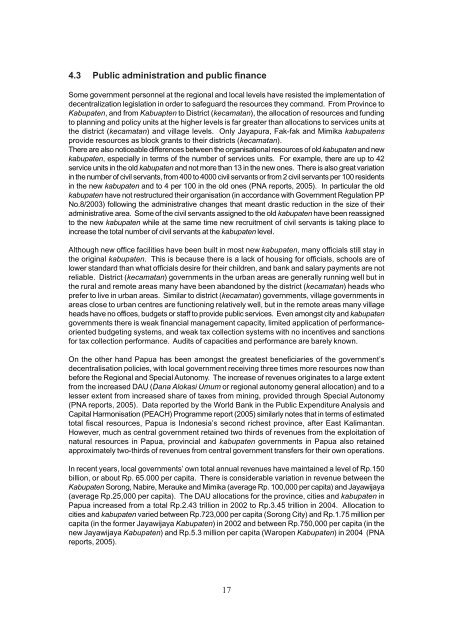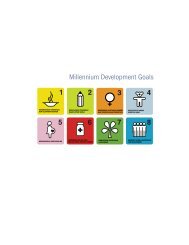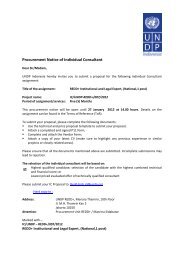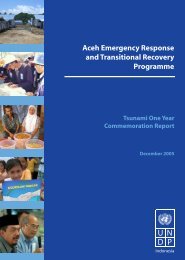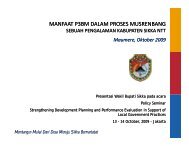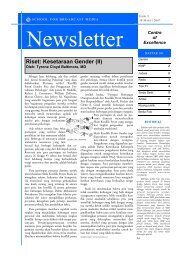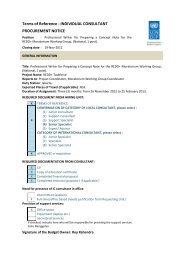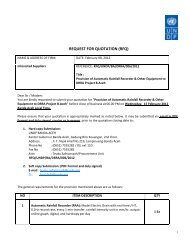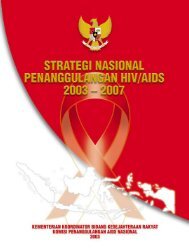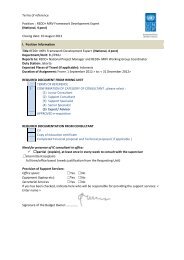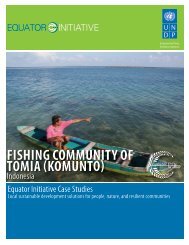Papua Needs Assessment - UNDP
Papua Needs Assessment - UNDP
Papua Needs Assessment - UNDP
You also want an ePaper? Increase the reach of your titles
YUMPU automatically turns print PDFs into web optimized ePapers that Google loves.
4.3 Public administration and public finance<br />
Some government personnel at the regional and local levels have resisted the implementation of<br />
decentralization legislation in order to safeguard the resources they command. From Province to<br />
Kabupaten, and from Kabuapten to District (kecamatan), the allocation of resources and funding<br />
to planning and policy units at the higher levels is far greater than allocations to services units at<br />
the district (kecamatan) and village levels. Only Jayapura, Fak-fak and Mimika kabupatens<br />
provide resources as block grants to their districts (kecamatan).<br />
There are also noticeable differences between the organisational resources of old kabupaten and new<br />
kabupaten, especially in terms of the number of services units. For example, there are up to 42<br />
service units in the old kabupaten and not more than 13 in the new ones. There is also great variation<br />
in the number of civil servants, from 400 to 4000 civil servants or from 2 civil servants per 100 residents<br />
in the new kabupaten and to 4 per 100 in the old ones (PNA reports, 2005). In particular the old<br />
kabupaten have not restructured their organisation (in accordance with Government Regulation PP<br />
No.8/2003) following the administrative changes that meant drastic reduction in the size of their<br />
administrative area. Some of the civil servants assigned to the old kabupaten have been reassigned<br />
to the new kabupaten while at the same time new recruitment of civil servants is taking place to<br />
increase the total number of civil servants at the kabupaten level.<br />
Although new office facilities have been built in most new kabupaten, many officials still stay in<br />
the original kabupaten. This is because there is a lack of housing for officials, schools are of<br />
lower standard than what officials desire for their children, and bank and salary payments are not<br />
reliable. District (kecamatan) governments in the urban areas are generally running well but in<br />
the rural and remote areas many have been abandoned by the district (kecamatan) heads who<br />
prefer to live in urban areas. Similar to district (kecamatan) governments, village governments in<br />
areas close to urban centres are functioning relatively well, but in the remote areas many village<br />
heads have no offices, budgets or staff to provide public services. Even amongst city and kabupaten<br />
governments there is weak financial management capacity, limited application of performanceoriented<br />
budgeting systems, and weak tax collection systems with no incentives and sanctions<br />
for tax collection performance. Audits of capacities and performance are barely known.<br />
On the other hand <strong>Papua</strong> has been amongst the greatest beneficiaries of the government’s<br />
decentralisation policies, with local government receiving three times more resources now than<br />
before the Regional and Special Autonomy. The increase of revenues originates to a large extent<br />
from the increased DAU (Dana Alokasi Umum or regional autonomy general allocation) and to a<br />
lesser extent from increased share of taxes from mining, provided through Special Autonomy<br />
(PNA reports, 2005). Data reported by the World Bank in the Public Expenditure Analysis and<br />
Capital Harmonisation (PEACH) Programme report (2005) similarly notes that in terms of estimated<br />
total fiscal resources, <strong>Papua</strong> is Indonesia’s second richest province, after East Kalimantan.<br />
However, much as central government retained two thirds of revenues from the exploitation of<br />
natural resources in <strong>Papua</strong>, provincial and kabupaten governments in <strong>Papua</strong> also retained<br />
approximately two-thirds of revenues from central government transfers for their own operations.<br />
In recent years, local governments’ own total annual revenues have maintained a level of Rp.150<br />
billion, or about Rp. 65.000 per capita. There is considerable variation in revenue between the<br />
Kabupaten Sorong, Nabire, Merauke and Mimika (average Rp. 100,000 per capita) and Jayawijaya<br />
(average Rp.25,000 per capita). The DAU allocations for the province, cities and kabupaten in<br />
<strong>Papua</strong> increased from a total Rp.2.43 trillion in 2002 to Rp.3.45 trillion in 2004. Allocation to<br />
cities and kabupaten varied between Rp.723,000 per capita (Sorong City) and Rp.1.75 million per<br />
capita (in the former Jayawijaya Kabupaten) in 2002 and between Rp.750,000 per capita (in the<br />
new Jayawijaya Kabupaten) and Rp.5.3 million per capita (Waropen Kabupaten) in 2004 (PNA<br />
reports, 2005).<br />
17


